“Rifugi” is an Italian word for mountain huts or refuges located in the mountains, such as the Alps. These huts offer not only a place to eat and rest during hikes, but also an overnight stay.
In the Italian Alps and Dolomites, the word “rifugi” refers to mountain huts (hotels) built for hikers, climbers, and other travelers. These are small houses or huts in the highlands where you can rest, spend the night, and find shelter from bad weather.
The history of rifugi dates back to the 19th century, when the first climbers and explorers began exploring the Alps. Today, their network includes hundreds of facilities located at various altitudes—from relatively accessible valleys to remote glacial regions.
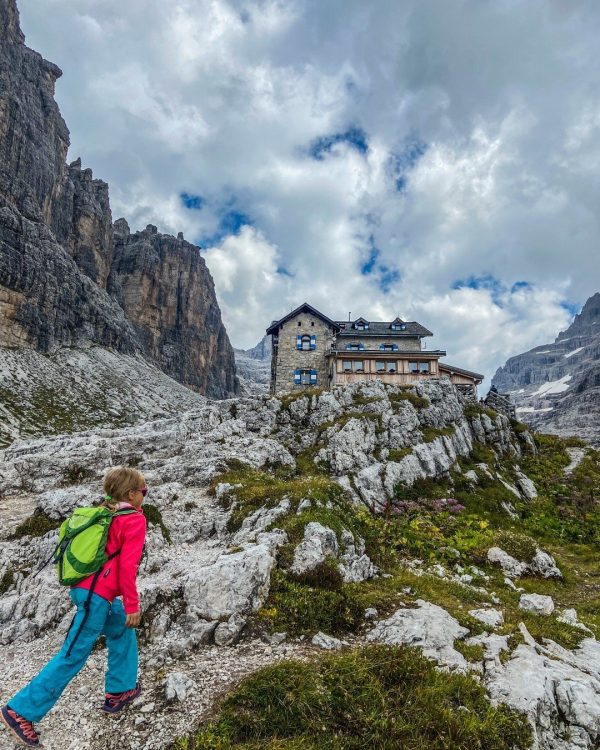
There are two types of rifugi:
- Guarded (guardati) – open seasonally and staffed by caretakers, offering hot meals, accommodation, and sometimes even showers;
- Unguarded (bivacchi) – open year-round, free of charge, but without staff or amenities.
Rifugi have become part of the Italian mountaineering culture. Tourists and climbers from all over the world meet here, share their impressions of the routes, and relax after challenging climbs. For many travelers, staying overnight in a rifugio is not only practical but also part of the romance of the mountains.
The most famous mountain huts (rifugi) in Italy:
1. Rifugio Auronzo (2320 m, Dolomites, Veneto region)
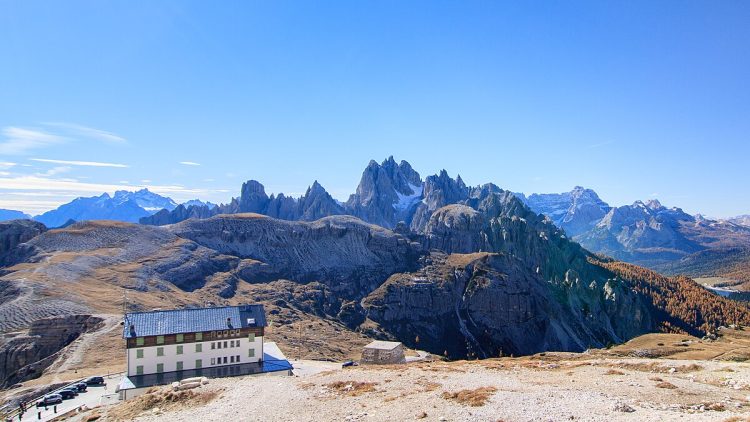
The most popular refuge at the foot of the Three Summits of Lavaredo (Tre Cime di Lavaredo). Easily accessible by car. The famous hiking routes around the peaks begin here.
-
Access: by car via the toll road from Misurina to the refuge parking lot.
-
This is one of the most easily accessible rifugi.
2. Rifugio Lagazuoi (2752 m, Dolomites, South Tyrol)
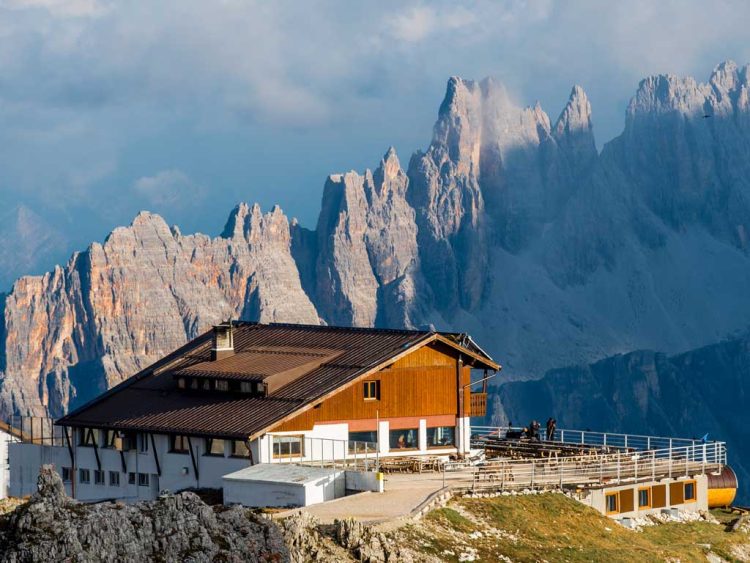
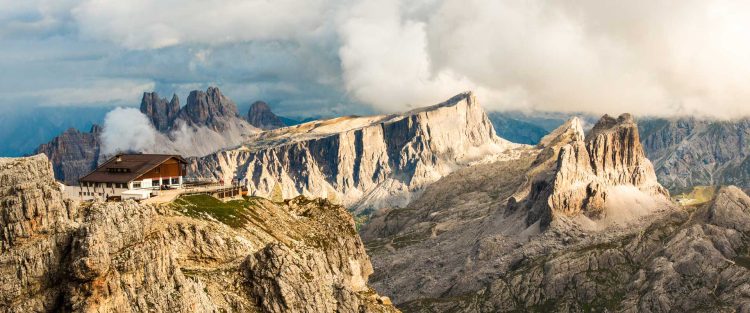
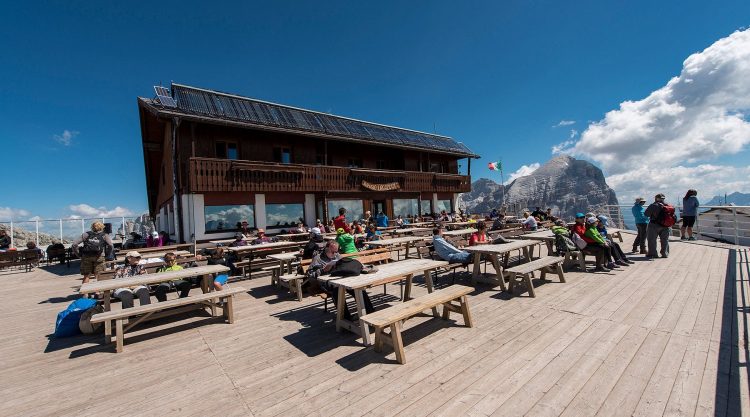
It is known for its panoramic views and the cable car leading directly to the refuge. Military tunnels from the First World War remain in the area.
-
Access: cable car from Falzarego Pass.
-
A hike along old military trails is also possible.
3. Rifugio Vittorio Emanuele II (2732 m, Val d’Aosta region)
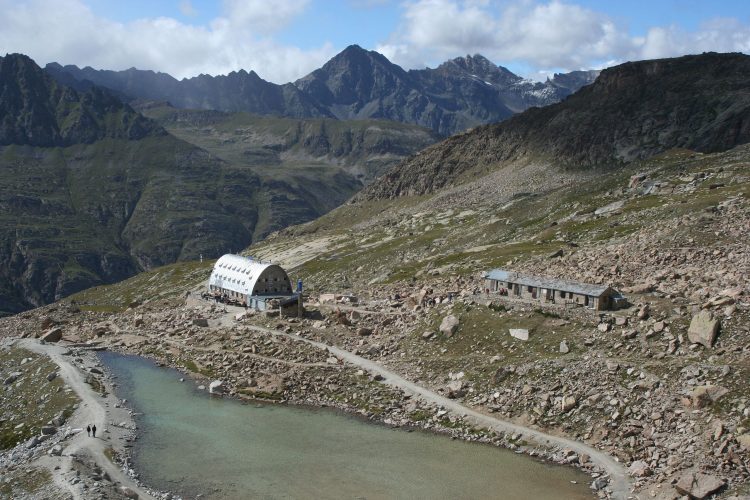
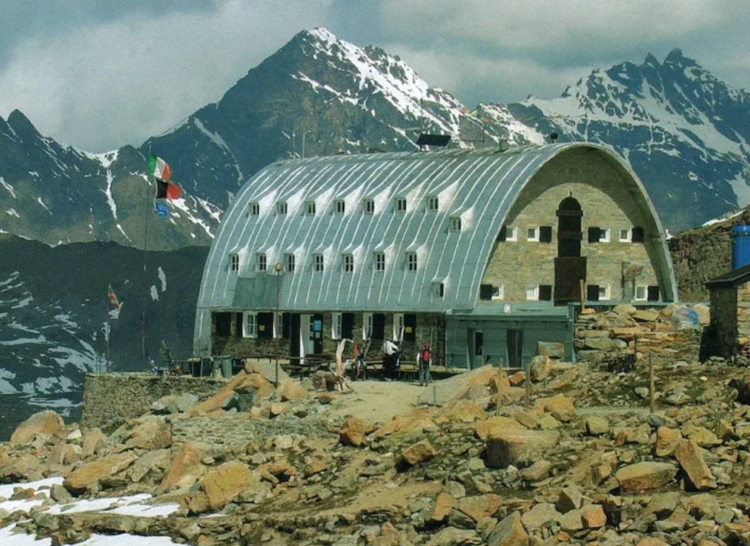
Starting point for the ascent to Gran Paradiso (4,061 m). One of the largest and most comfortable refuges.
-
Access: On foot from the village of Pont, the ascent takes about 3-4 hours.
-
The trail is well marked and suitable for acclimatization.
4. Rifugio Tuckett e Sella (2272 m, Dolomites, Trentino)
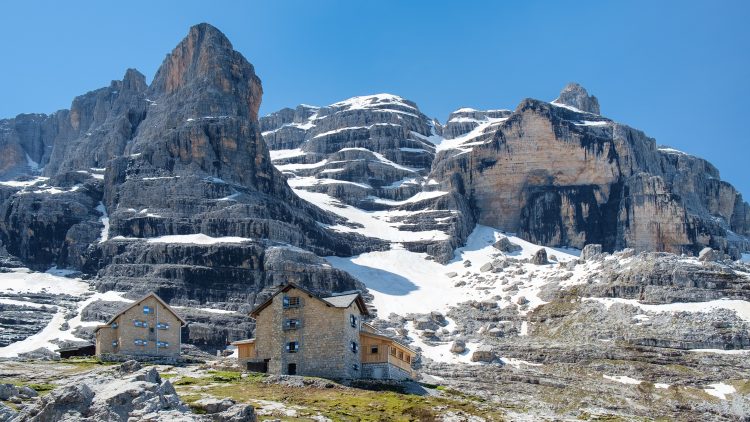
Located in the Brenta Massif. It has the atmosphere of a mountaineering center and is a popular spot among rock climbers.
-
Access: Hiking route from Groste Pass or from Val Rendena.
-
The ascent usually takes 2–3 hours.
5. Rifugio Torino (3375 m, Mont Blanc, Courmayeur, Val d’Aosta)
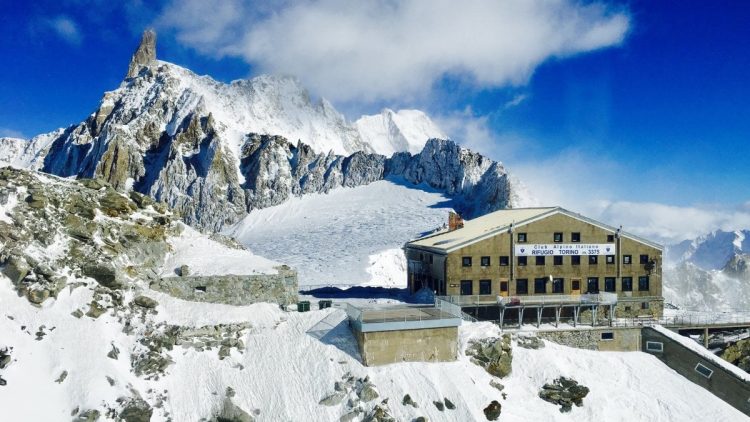
Accessible by the Skyway Monte Bianco cable car. One of the best vantage points for viewing the Mont Blanc glaciers.
-
Access: modern cable car Skyway Monte Bianco from Courmayeur.
-
From station Punta Helbronner is a few minutes’ walk away.
6. Rifugio Locatelli (2405 m, Dolomites, South Tyrol)
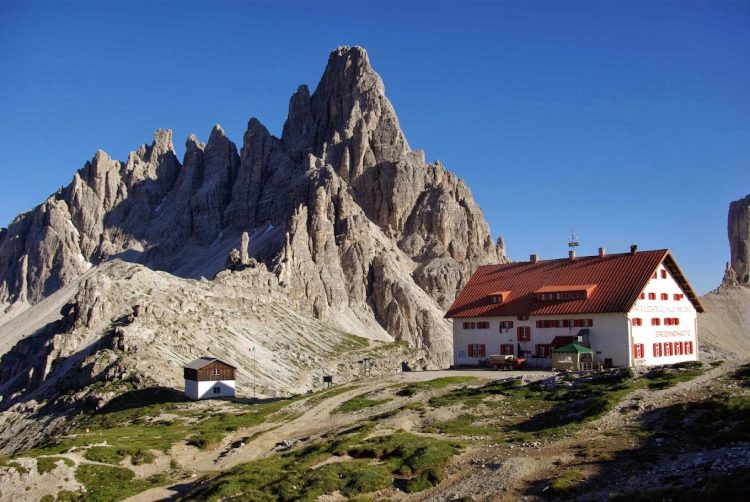
An iconic spot for photographers – it offers a classic view of the Three Battlements (Tre Cime di Lavaredo). A very popular route among tourists.
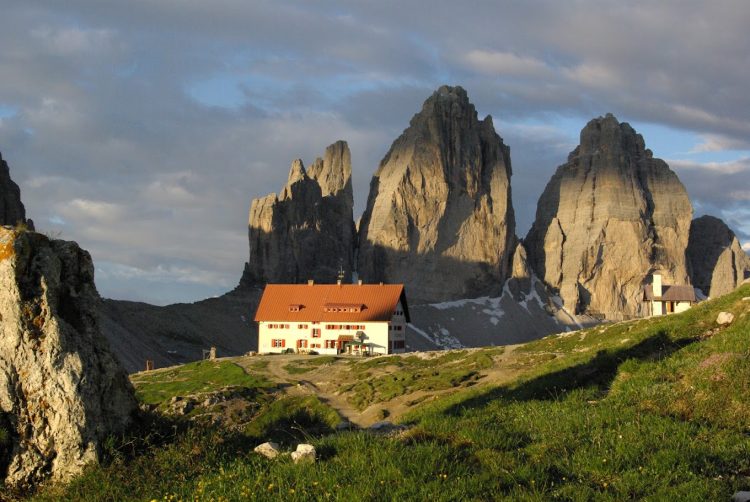
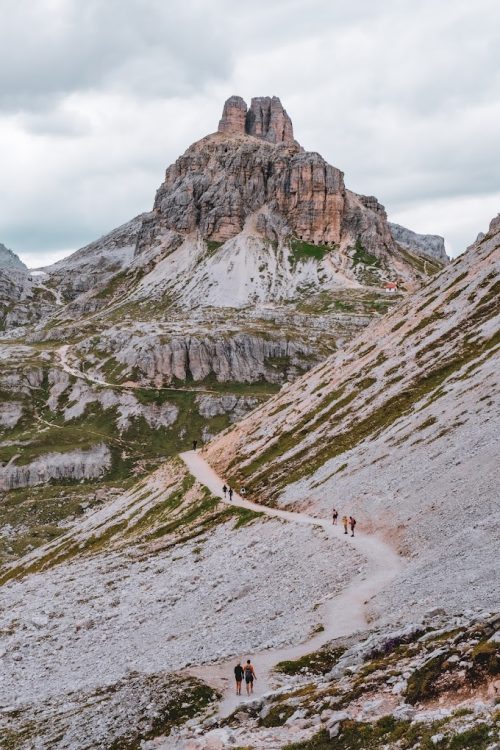
-
Access: on foot from Rifugio Auronzo (approximately 1.5–2 hours along a popular route).
-
This is one of the most photographed spots in the Dolomites.
7. Rifugio Gnifetti (3647 m, Monte Rosa massif, Piedmont)
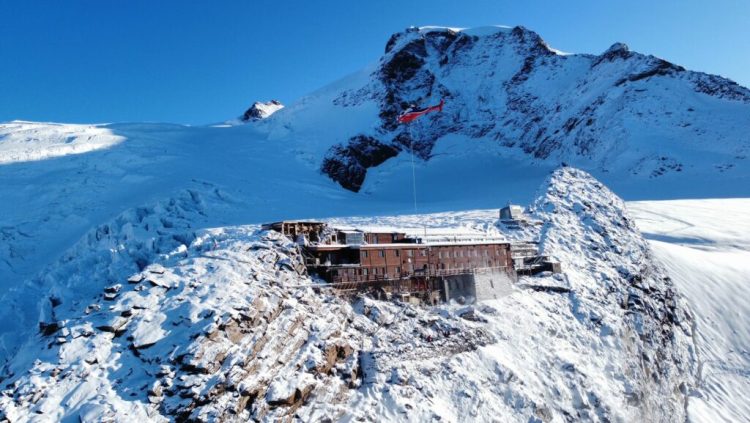
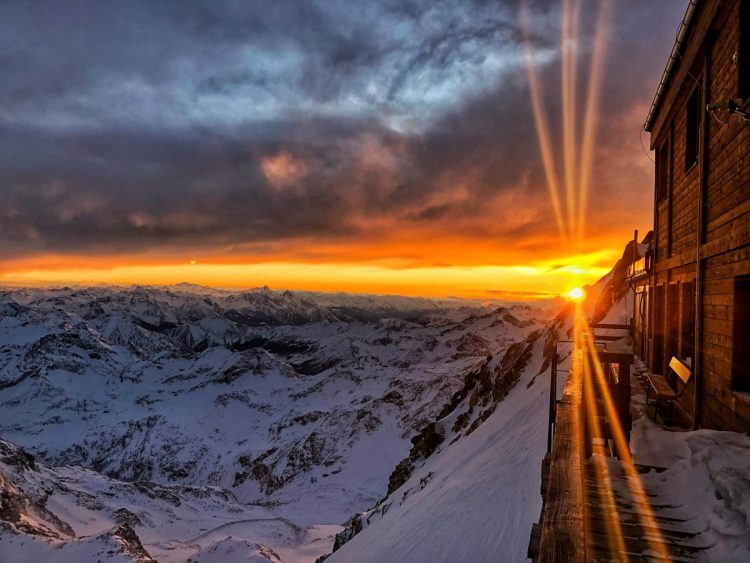
High-mountain shelter for climbers.Used for acclimatization before climbing the four-thousanders of Monte Rosa.
-
Access: from the village of Gressoney-la-Trinité by cable car to Indren (3260 m), then walk for about 1.5–2 hours across the glacier.
-
Mountaineering equipment required equipment.
8. Rifugio Velo della Madonna (2358 m, Pale di San Martino)
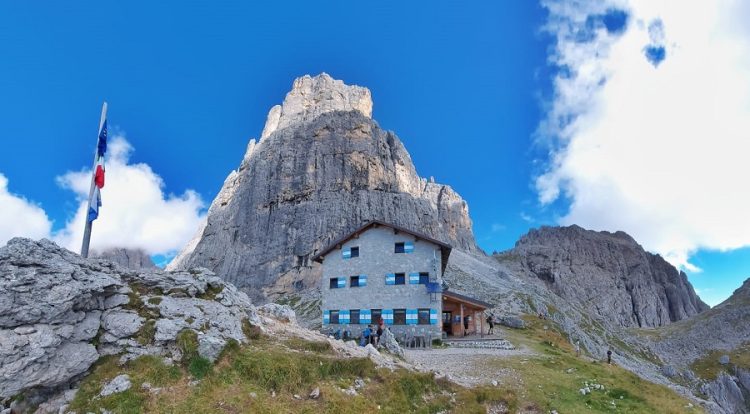
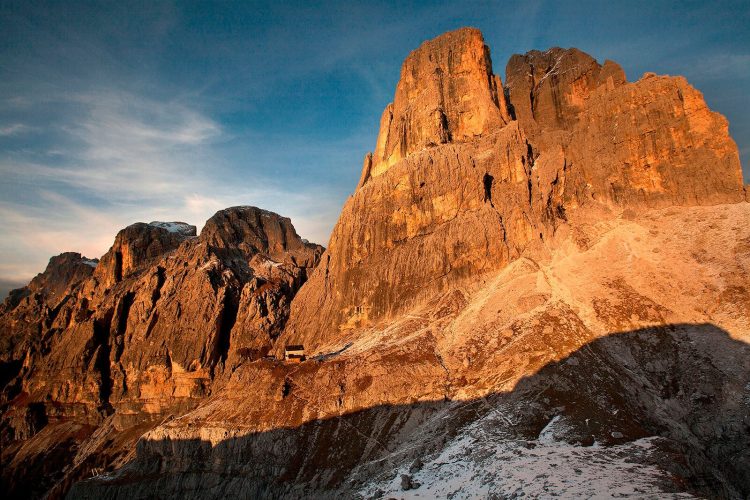
-
Access: on foot from San Martino di Castrozza along the trail through Val di Roda.
-
The ascent takes about 3-4 hours, the route is considered difficult.
9. Rifugio Angelo Alimonta (2580 m, Brenta Dolomites)
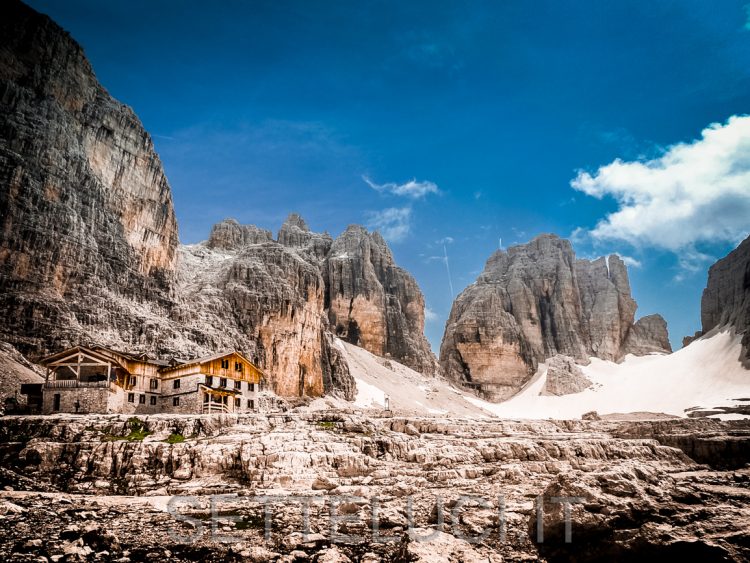
-
Access: On foot from Groste Pass or via Val Brenta along the Bocchette trail.
-
The ascent usually takes 3–4 hours; it is a popular base for climbing.
10. Rifugio Brentei (2182 m, Brenta Dolomites)
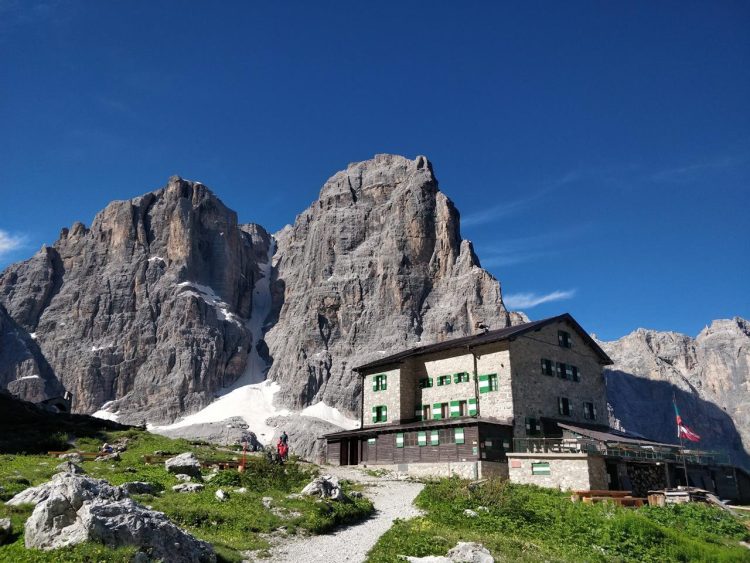
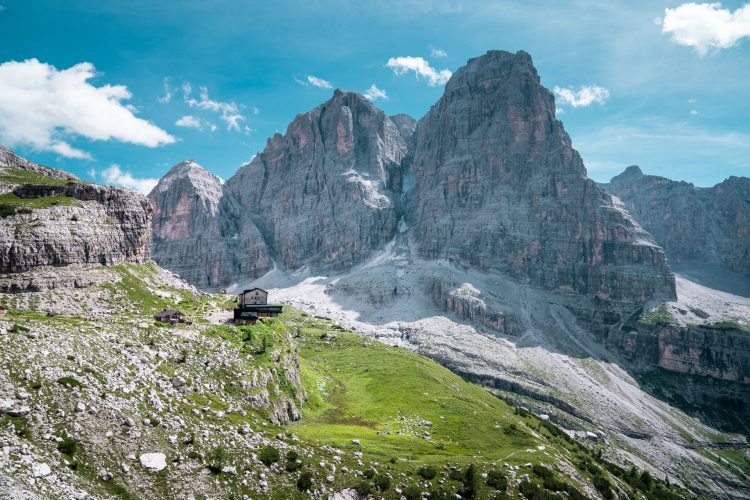
-
Access: via trail from Val Brenta, route approximately 2-3 hours.
-
From here, people often continue to the Rifugio Alimonta.
11. Rifugio Silvio Agostini (2410 m, Brenta Dolomites)
The Silvio Agostini refuge, built in 1937 and modified in 1975, is located at an altitude of 2410 meters in the Ambiese Valley in the Brenta Dolomites. Its proximity to several small natural climbing walls has made it a popular The site of summer climbing courses organized by the National School of Mountaineering “Giorgio Graffer” of the SAT, which also owns the refuge itself.
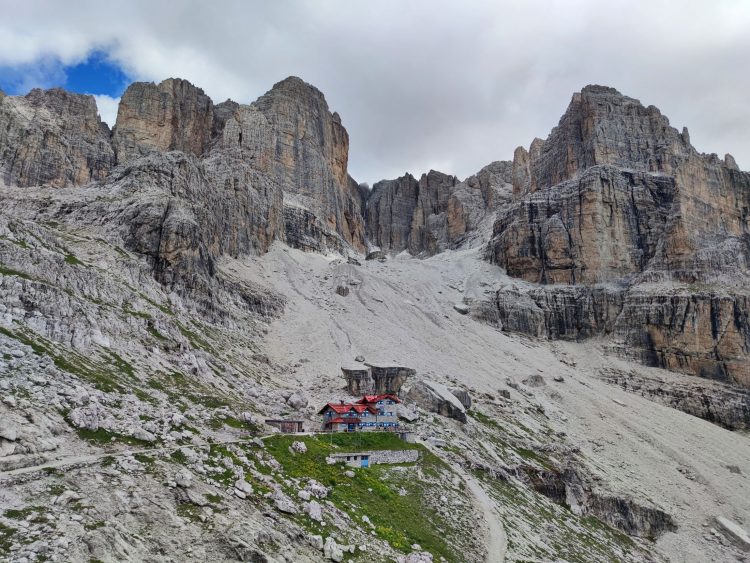
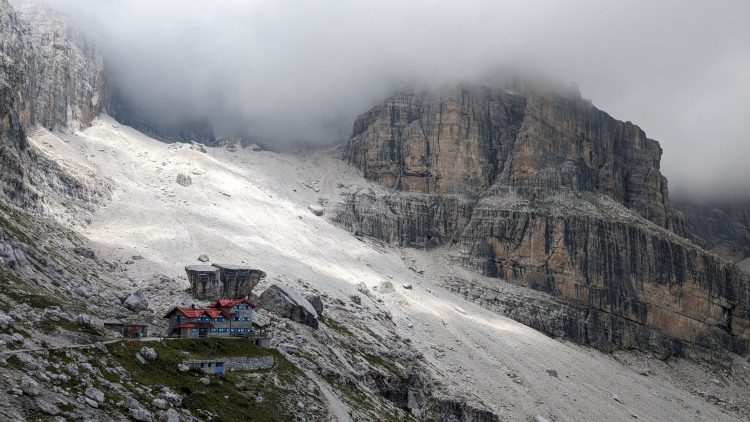
-
Access: climb from the village of San Lorenzo in Banale via Val Ambiez.
-
You can take a jeep taxi to Malga Senaso, then walk for 2–3 hours.
12. Rifugio Bruto Carestiato (1834 m, Dolomites)
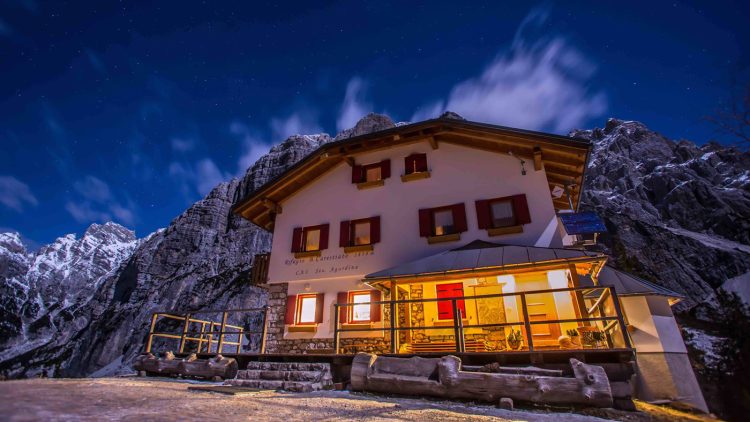
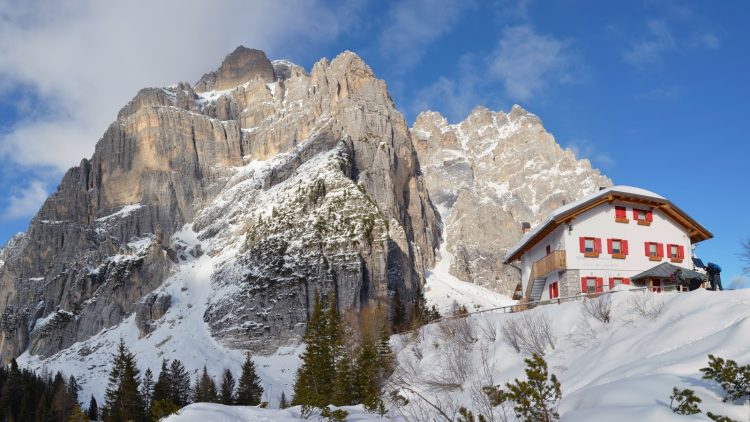
-
Access: from Passo Duran on foot, about 1.5–2 hours.
-
Suitable for an easy walk and a family holiday.
13. Rifugio Pradidali (2278 m, Pale di San Martino)
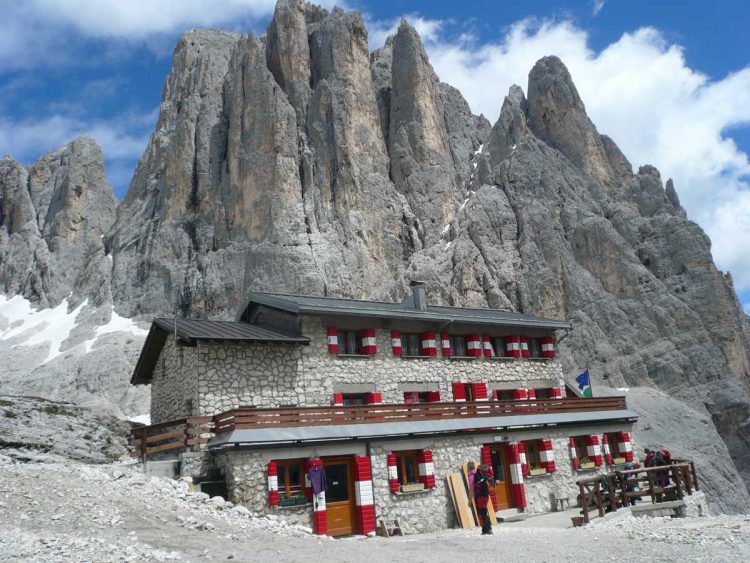
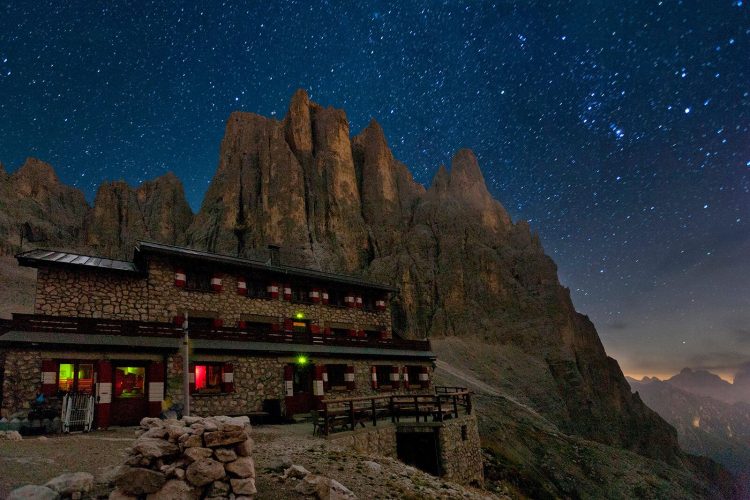
-
Access: on foot from San Martino di Castrozza via Val Canali.
-
The ascent takes approximately 3 hours.
14. Rifugio Fonda Savio (2367 m, Dolomites, Tre Cime area)
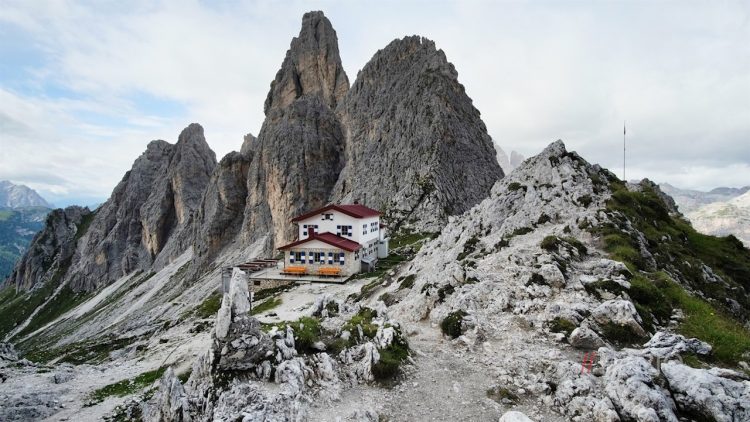
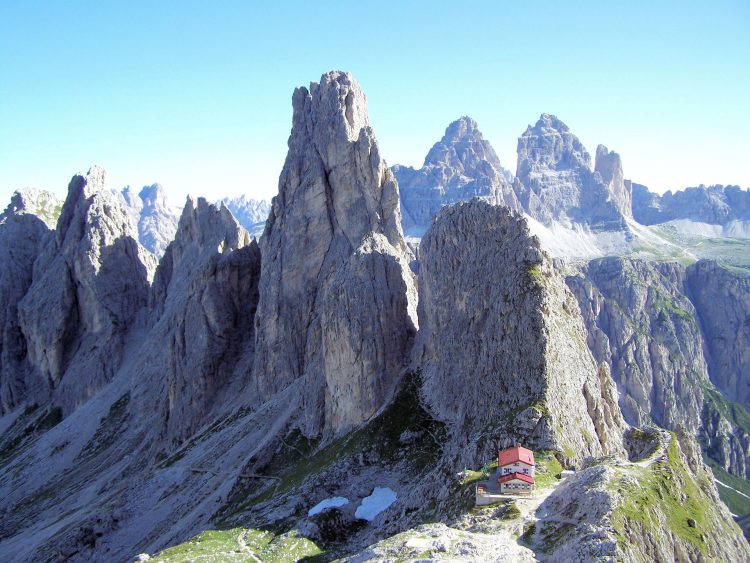
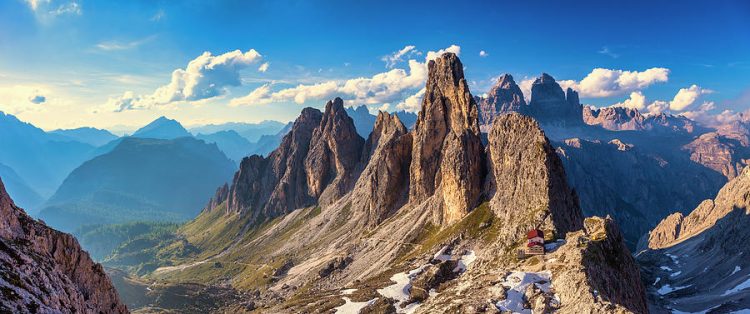
-
Access: on foot from Misurina (via Lago Antorno), about 2-3 hours.
-
A small but very picturesque refuge.
15. Rifugio Ottone Brentari (2480 m, Pale di San Martino)
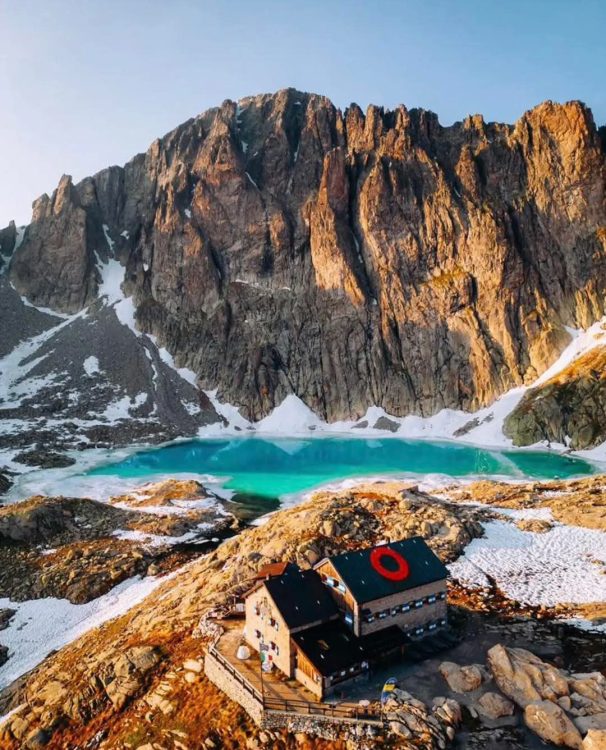
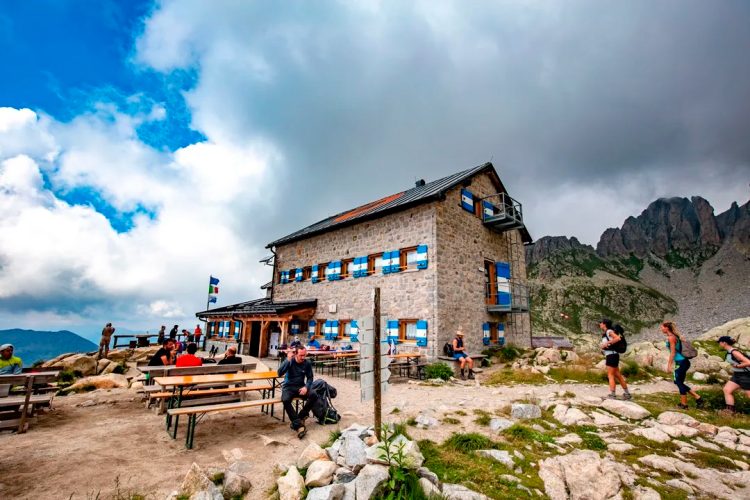
-
Access: from San Martino di Castrozza via the trail via Col Verde and Rosetta Plateau.
-
Ascent time: about 2–3 hours.
16. Rifugio Coldai Sonino (2135 m, Dolomites, Civetta group)
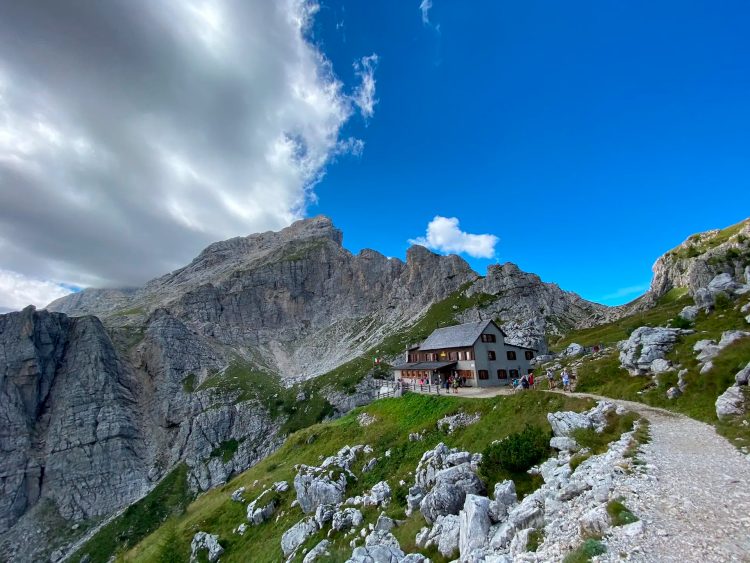
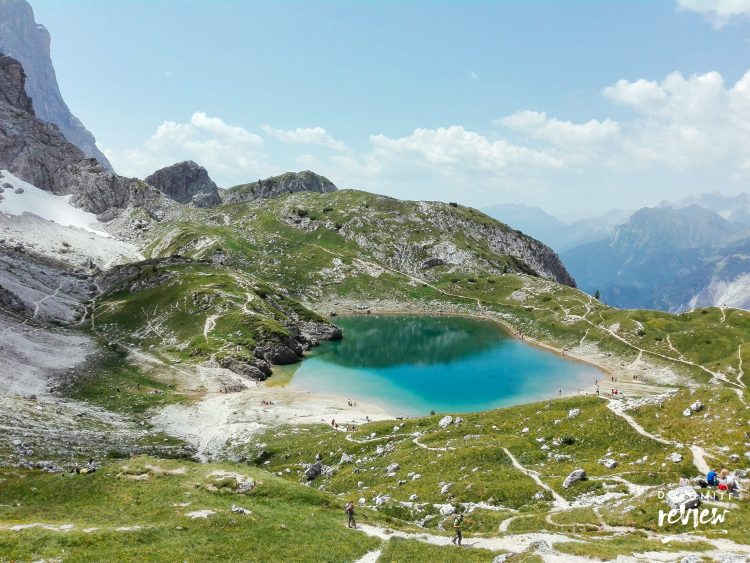
-
Access: on foot from Alleghe or from Palafavera (road from Val di Zoldo).
-
The climb usually takes about 2 hours.
Average cost of an overnight stay at each of the above Rifugi:
1. Rifugio Auronzo – €25–35 (CAI member), €40–60 (guests).
2. Rifugio Lagazuoi – €30–40 (CAI), €55–70 (guests, including half board).
3. Rifugio Vittorio Emanuele II – €25–35 (CAI), €45–55 (guests).
4. Rifugio Tuckett e Sella – €25–35 (CAI), €40–55 (guests).
5. Rifugio Torino – €40–50 (CAI), €70–90 (guests, due to altitude and location).
6. Rifugio Locatelli – €25–35 (CAI), €45–60 (guests).
7. Rifugio Gnifetti – €35–45 (CAI), €60–80 (guests, due to the mountaineering nature).
8. Rifugio Velo della Madonna – €25–35 (CAI), €45–55 (guests).
9. Rifugio Angelo Alimonta – €25–35 (CAI), €45–60 (guests).
10. Rifugio Brentei – €25–35 (CAI), €45–55 (guests).
11. Rifugio Silvio Agostini – €25–35 (CAI), €45–55 (guests).
12. Rifugio Bruto Carestiato – €20–30 (CAI), €35–50 (guests).
13. Rifugio Pradidali – €25–35 (CAI), €45–55 (guests).
14. Rifugio Fonda Savio – €25–35 (CAI), €40–50 (guests).
15. Rifugio Ottone Brentari – €25–35 (CAI), €45–55 (guests).
16. Rifugio Coldai Sonino – €25–35 (CAI), €45–55 (guests).
👉 Important: almost all rifugi offer half board (dinner + breakfast), which costs separately: on average €25–35.
👉 Members of Alpine clubs (CAI, DAV, ÖAV, etc.) receive a discount of approximately 30–40% on overnight stays.
* For Information: CAI is the Club Alpino Italiano (Italian Alpine Club).
-
Founded in 1863 in Turin.
-
It is the largest mountaineering and hiking organization in Italy (over 300,000 members).
-
Membership provides discounts on overnight stays in rifugi (usually 30-40%), mountain accident insurance, and access to mountaineering courses.
-
CAI has partnership agreements with other European Alpine clubs: the German DAV, the Austrian ÖAV, the Swiss SAC, and others.
This means that if you are a member of at least one of these clubs, you also receive a discount at Italian mountain huts (rifugi).
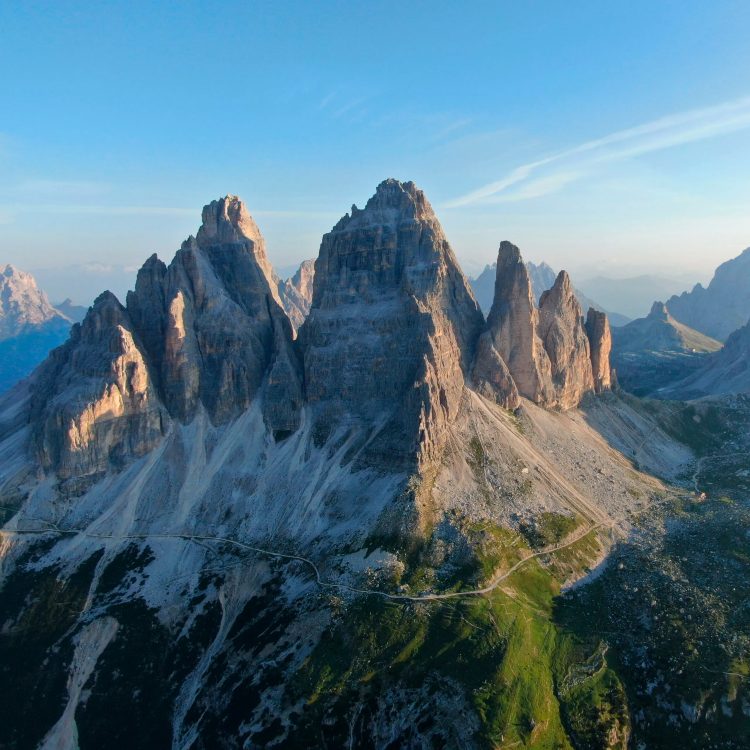
Simple Rifugi difficulty scale:
-
1/5 – easy hike (suitable even for families with children).
-
2/5 – moderate trail (minimal clothing and footwear required).
-
3/5 – Requires endurance and basic mountain trekking experience.
-
4/5 – Difficult route, possible steep sections and exposure.
-
5/5 – Mountaineering route, requires special equipment.
Difficulty of trekking routes to the above-mentioned Rifugi:
1. Rifugio Auronzo (2320 m) – 1/5
(almost by the road, accessible by car).
2. Rifugio Lagazuoi (2752 m) – 1–2/5
(can be reached by cable car; walking is a bit more difficult, but not extreme).
3. Rifugio Vittorio Emanuele II (2732 m) – 3/5
(3–4 hours of ascent, significant elevation gain).
4. Rifugio Tuckett e Sella (2272 m) – 3/5
(a long, but well-marked route).
5. Rifugio Torino (3375 m) – 1/5
(the Skyway Monte Bianco cable car takes you almost directly to the refuge).
6. Rifugio Locatelli (2405 m) – 2/5
(1.5–2 hours walk, popular but not difficult trail).
7. Rifugio Gnifetti (3647 m) – 5/5
(only with mountaineering equipment, moving on a glacier).
8. Rifugio Velo della Madonna (2358 m) – 4/5
(3–4 hours, steep rocky sections, exposure (route exposure above the cliff) at the end. That is, a section of the trail runs along a narrow ledge or slope with a steep cliff nearby. The route itself may not be technically very difficult, but it can be psychologically dangerous: if you slip, the risk of falling is high. Therefore, routes with “exposure” require good footwear, attentiveness, and sometimes insurance (rope, helmet).
9. Rifugio Angelo Alimonta (2580 m) – 4/5
(High-mountain route, about 4 hours of ascent, surrounded by cliffs).
10. Rifugio Brentei (2182 m) – 3/5
(Relatively accessible, but still requires endurance).
11. Rifugio Silvio Agostini (2410 m) – 4/5
(Ascent via Val Ambiez, jeep taxi assistance is possible, but the trail higher up is difficult).
12. Rifugio Bruto Carestiato (1834 m) – 2/5
(an easy climb from Passo Duran, recommended for beginners).
13. Rifugio Pradidali (2278 m) – 3/5
(about 3 hours, a good route, but requires strength).
14. Rifugio Fonda Savio (2367 m) – 3/5
(2-3 hours, rocky paths, but no serious dangers).
15. Rifugio Ottone Brentari (2480 m) – 3/5
(2-3 hours along a plateau, fairly accessible, but at altitude).
16. Rifugio Coldai Sonino (2135 m) – 2–3/5
(about 2 hours, classic route, accessible to most).
Rifugi and Route Safety
* Exposure (route exposure above the cliff) at the end. This means that a section of the trail runs along a narrow ledge or slope with a steep cliff nearby. The route itself may not be technically difficult, but it can be psychologically dangerous: if you slip, the risk of falling is high. Therefore, routes with “exposure” require good footwear, attentiveness, and sometimes safety equipment (rope, helmet).
♦ Safe routes (no exposure, suitable for beginners):
-
Rifugio Auronzo (2320 m) – access by road, safe.
-
Rifugio Torino (3,375 m) – ascent by cable car, safe.
-
Rifugio Bruto Carestiato (1,834 m) – an easy trail from Passo Duran.
-
Rifugio Coldai Sonino (2,135 m) – a classic route, cliffs are far away.
-
Rifugio Lagazuoi (2752 m) – a slightly more difficult hike, but the trail is safe.
-
Rifugio Locatelli (2405 m) – a popular route, no exposé.
♦ Moderate difficulty (rocky in places, steep, but no open cliffs):
-
Rifugio Vittorio Emanuele II (2732 m) – a long climb, but without exposure.
-
Rifugio Tuckett e Sella (2272 m) – a trail with rocky sections.
-
Rifugio Pradidali (2278 m) – demanding, but safe.
-
Rifugio Fonda Savio (2367 m) – rocks, but no cliffs.
-
Rifugio Ottone Brentari (2480 m) – accessible, but at altitude.
-
Rifugio Brentei (2182 m) – difficult in places, but without exposure.
♦ Difficult routes (there is exposure, caution and experience are required):
-
Rifugio Velo della Madonna (2358 m) – the final section goes along a narrow rocky path, there are cliffs. 🔴 Exposure!
-
Rifugio Angelo Alimonta (2580 m) – a high-altitude route, a trail with open slopes. 🔴 Exposure!
-
Rifugio Silvio Agostini (2410 m) – the upper part of the route runs along open rock ridges. 🔴 Exposure!
For climbers only:
-
Rifugio Gnifetti (3647 m) – glacier travel, helmet, crampons, roped rope, and experience required.
Source of material: alp.org.ua

